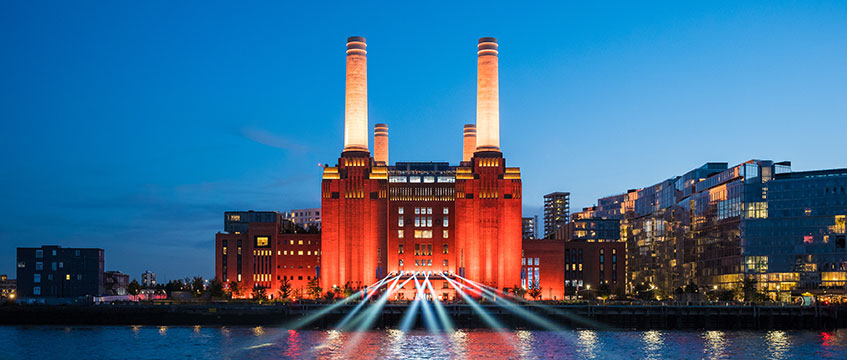Over almost 40 years, there have been several attempts to redevelop the iconic Battersea Power Station, SW8. As the building at the heart of the site finally reopens to the public, EG looks back through the archives to trace the successes and failures.
1983 Battersea Power Station is closed and subsequently decommissioned.
1984 Owner, John Broome, the man behind Alton Towers, announced plans to build an indoor theme park on the site.
1989 The theme park project is halted owing to a lack of funding, but not before the removal of the roof, which leaves the structure severely weakened.
1993 Development company Parkview International, backed by the Hwang family, purchases outstanding loans and acquires the freehold.
2003 Parkview starts on a £1.1bn project to restore the building and redevelop the 38-acre site into a retail, housing and leisure complex – but barely any progress is made.
2006 Real Estate Opportunities purchases Battersea Power Station for £400m from Victor Hwang. REO is controlled by Treasury Holdings, the Irish property development company headed by Johnny Ronan and Richard Barrett.
2007 Architect Rafael Viñoly is brought on board to masterplan REO’s revised proposals for Battersea.
2008 Treasury brings Rob Tincknell onto the project. Tincknell had overseen the 52-acre regeneration of Spencer Dock in Dublin for Treasury and the company’s Dongtan Eco-City in Shanghai.
2009 REO directors state that there are “material uncertainties” concerning the company’s ability to continue following the financial crisis.
February 2011 The £5.5bn plans, designed by Viñoly, the largest ever submitted in central London, gain planning permission.
December 2011 The Battersea Power Station site goes into administration as a result of outstanding debt owed by REO to Lloyds and Nama.
July 2012 The sale of the project to a Malaysian consortium comprising SP Setia, Sime Darby and Employees Provident Fund for £400m renews faith in the scheme.
Progress starts to be made: some tweaks are made to the design and scores of flats at the development are pre-sold to overseas investors.
July 2013 Work finally begins, heralded by London mayor Boris Johnson as a “triumphant moment”.
October 2013 Frank Gehry and Lord Foster are appointed to design an eight-acre phase of the redevelopment.

April 2014 Gehry Partners and Foster + Partners-designed plans for the 1,300-home third phase are unveiled. They include a new high street, known as Electric Boulevard, to run from the new Underground station up to the Power Station. Watch Frank Gehry’s interview with EG at the unveiling >>
October 2014 Exhibitions to lure businesses and homebuyers to the Battersea Power Station development are launched in cities around the world.
The developers secure £1.35bn of funding to finance the third phase from a lending consortium including CIMB, Maybank and Standard Chartered Bank.
2016 Apple signs a lease for 500,000 sq ft, marking a key turning point for the scheme’s commercial success.
2017 The development’s first phase, Circus West Village, completes and becomes home to more than 1,000 residents.
June 2017 Wandsworth Council allows the delivery of 250 of the required 636 affordable homes at Battersea Power Station to be delayed pending a viability review. The decision attracts the fury of London mayor Sadiq Khan.
April 2018 Battersea Power Station Development Company announces that Rob Tincknell is to step down as chief executive after 10 years at the helm of one of London’s most challenging projects.

June 2018 1,300-home phase three starts.
August 2018 Business members club No18, part of IWG, takes 40,000 sq ft to create a “bespoke workspace offering” known as the Engine Room in the Power Station building.
March 2019 The £1.6bn sale of the commercial buildings in phase two – including the iconic power station itself – to its Malaysian investors Permodalan Nasional Berhad, one of the largest asset managers in Malaysia, and the Employees Provident Fund of Malaysia completes.
September 2019 Battersea Power Station secures a £600m debt facility from the project’s consortium of lenders, including Standard Chartered Bank, CIMB Bank, Maybank and OCBC Bank, to bring forward phase three.
March 2020 Construction firms Multiplex and Mace close some of London’s largest developments due to the Covid-19 pandemic – including Battersea Power Station.
September 2021 Northern Line stations open at Battersea and Nine Elms, after a decade in the making.
October 2021 Fashion chains Ralph Lauren, Calvin Klein, Tommy Hilfiger and Lacoste are among a growing list of retailers agreeing to take new stores at the £9bn redevelopment.

June 2022 Battersea offers the first glimpse of the restored power station control room at the centre of the £9bn regeneration, which has created 3.5m sq ft of commercial space and 4,239 homes.
October 2022 A decade after the latest redevelopment attempt began, the power station is finally reopened to the public.
To send feedback, e-mail julia.cahill@eg.co.uk or tweet @EGJuliaC or @EGPropertyNews











